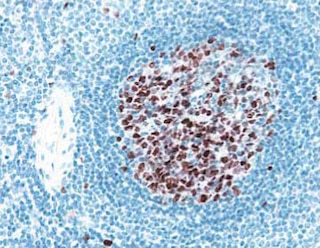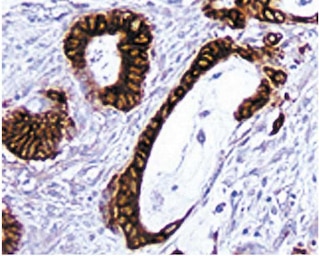-
Your selected country is
Middle East / Africa
- Change country/language
Old Browser
This page has been recently translated and is available in French now.
Looks like you're visiting us from {countryName}.
Would you like to stay on the current country site or be switched to your country?




Western blot and Immunohistochemical analyses of RUNX3 expression. Left Panel: Western blot analysis of RUNX3 expression in Jurkat cell lysate. Lysate was prepared from cells of the human Jurkat (Acute T cell leukemia, ATCC TIB-152) cell line. Cell lysate proteins were resolved by electrophoresis (SDS-PAGE) in a 4-20% Tris-Glycine polyacrylamide gel, transferred to PVDF membranes and then probed with 1 µg/ml of Purified Anti-RUNX3 antibody (Cat. No. 564813) followed by HRP-conjugated Goat Anti-Mouse IgG (Cat. No. 554002), and ECL Western blot detection reagents. RUNX3 was identified as protein bands of approximately 40 to 50 kDa. Right Panel: Immunohistochemical staining of RUNX3 expressed in human tonsillar cells. Following antigen retrieval with BD Retrievagen A Buffer (Cat. No. 550524), the formalin-fixed paraffin-embedded tonsil sections were stained with either Purified Mouse IgG1 κ Isotype Control (Cat. No. 550878; Left Image) or Purified Mouse Anti-RUNX3 antibody (Cat. No.564813; Right Image). A three-step staining procedure that employs a Biotin Goat Anti-Mouse Immunoglobulin (Cat. No. 550337), Streptavidin-Horseradish Peroxidase (HRP) (Cat. No.550946), and the DAB Substrate Kit (Cat. No. 550880) was used to develop the primary staining reagents. As shown in the Right Image, the RUNX3-specific antibody primarily stained the nuclei of some tonsillar lymphocytes. Original magnification: 40×.


BD Pharmingen™ Purified Mouse Anti-RUNX3

Regulatory Status Legend
Any use of products other than the permitted use without the express written authorization of Becton, Dickinson and Company is strictly prohibited.
Preparation And Storage
Product Notices
- Please refer to www.bdbiosciences.com/us/s/resources for technical protocols.
- Since applications vary, each investigator should titrate the reagent to obtain optimal results.
- Caution: Sodium azide yields highly toxic hydrazoic acid under acidic conditions. Dilute azide compounds in running water before discarding to avoid accumulation of potentially explosive deposits in plumbing.
- Sodium azide is a reversible inhibitor of oxidative metabolism; therefore, antibody preparations containing this preservative agent must not be used in cell cultures nor injected into animals. Sodium azide may be removed by washing stained cells or plate-bound antibody or dialyzing soluble antibody in sodium azide-free buffer. Since endotoxin may also affect the results of functional studies, we recommend the NA/LE (No Azide/Low Endotoxin) antibody format, if available, for in vitro and in vivo use.
- An isotype control should be used at the same concentration as the antibody of interest.
- Species cross-reactivity detected in product development may not have been confirmed on every format and/or application.
Companion Products






The R3-5G4 monoclonal antibody specifically binds to Runt-related transcription factor 3 (RUNX3) which is also known as Acute myeloid leukemia 2 protein (AML2), Core-binding factor subunit alpha-3 (CBFA3), and Polyomavirus enhancer-binding protein 2 alpha C subunit (PEBP2aC). RUNX3 is a member of the RUNX transcription factor family which includes RUNX1-3. RUNX3 is a key regulator of gene expression related to the development and differentiation of cells within the nervous and immune systems. In the immune system, RUNX3 is particularly involved in the commitment of CD8+ T cells in the thymus. RUNX3 is highly expressed and essential for the cytotoxic functions of NK cells, peripheral CD8+T cells and CD4+CD8αα intraepithelial lymphocytes in the gut. RUNX3 also plays a role in the differentiation and effector functions of Th1 cells. RUNX3 is activated downstream of the TGF-β signaling pathway and can play a role in tumor suppression. Aberrant expression of RUNX3 has been associated with tumorigenesis including the development of gastric and other cancers.
Development References (6)
-
Chuang LS, Ito K, Ito Y. RUNX family: Regulation and diversification of roles through interacting proteins. Int J Cancer. 2013; 132(6):1260-1271. (Biology). View Reference
-
Djuretic IM, Cruz-Guilloty F, Rao A. Regulation of gene expression in peripheral T cells by Runx transcription factors. Adv Immunol. 2009; 104(1):23. (Biology). View Reference
-
Ito K, Liu Q, Salto-Tellez M, et al. RUNX3, a novel tumor suppressor, is frequently inactivated in gastric cancer by protein mislocalization. Cancer Res. 2005; 65(17):7743-7750. (Immunogen: Western blot). View Reference
-
Lotem J, Levanon D, Negreanu V, Leshkowitz D, Friedlander G, Groner Y. Runx3-mediated transcriptional program in cytotoxic lymphocytes. PLoS ONE. 2013; 8(11):e80467. (Biology). View Reference
-
Reis BS, Rogoz A, Costa-Pinto FA, Taniuchi I, Mucida D. Mutual expression of the transcription factors Runx3 and ThPOK regulates intestinal CD4(+) T cell immunity. Nat Immunol. 2013; 14(3):271-280. (Biology). View Reference
-
Setoguchi R, Tachibana M, Naoe Y, et al. Repression of the transcription factor Th-POK by Runx complexes in cytotoxic T cell devel. Science. 2008; 19(5864):822-825. (Biology). View Reference
Please refer to Support Documents for Quality Certificates
Global - Refer to manufacturer's instructions for use and related User Manuals and Technical data sheets before using this products as described
Comparisons, where applicable, are made against older BD Technology, manual methods or are general performance claims. Comparisons are not made against non-BD technologies, unless otherwise noted.
For Research Use Only. Not for use in diagnostic or therapeutic procedures.
Report a Site Issue
This form is intended to help us improve our website experience. For other support, please visit our Contact Us page.